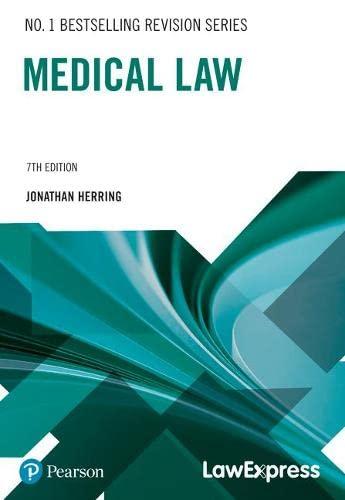Question
Sarah is an Australian supermodel who began an intensive fitness program to prepare for her appearance in a TV Commercial for gym equipment. She knew
Sarah is an Australian supermodel who began an intensive fitness program to prepare for her appearance in a TV Commercial for gym equipment. She knew that she needed to be very fit. In addition to her fitness program, she decided to consult a dietician about what sort of food she should eat. The dietician suggested that she have at least one protein smoothie every day. Sarah researched a range of blenders that might suit her needs. At her local electrical store, she found that the only blenders for sale there did not meet her needs as they were not powerful enough to produce smoothies. Sarah kept looking. She had heard good things about the Homeware Store so she decided to go there to purchase a blender that met her needs. She was very happy to find that a blender was on sale at the Homeware Store. A sign advertising the blender stated: It is high quality, superb, safe and durable. You won't regret it. She purchased the blender and kept her receipt. Once home, she unpackaged the blender and as soon as she plugged it in, the upper lid came off and the sharp blades flew out, badly injuring her right hand. At the hospital, a doctor explained to Sarah that she would need stitches in her hand, and she would be unable to use her hand for four weeks unless the cut had healed, so the stitches could be removed. Sarah was very upset when she realised that she would not be able to participate in the planned TV Commercial and that another supermodel would have to take her place. This also meant she would lose the $12,000 fee that she would have received for the commercial.
Use the IRAC method to advise Sarah about the remedies she may seek under Contract Law in Australia.
answer this based on this learning material
Rescission Rescission entitles the injured party to set the contract aside and is only available for breach of a condition The right to rescission is lost if the injured party: - continues with the transaction; - fails to act or act within a reasonable time; or - if an innocent third party acquires an interest in the subject matter
Restitution Restitution is based on the concept of unjust enrichment. The plaintiff must establish: The defendant must obtain a benefit or enrichment; The benefit was at the plaintiff's expense; It would be unjust to allow the defendant to keep that benefit or enrichment; and The defendant has no defences to rely upon
Restitution Restitution can be used if: The defendant has received a sum of money from the plaintiff and there has been a total failure of consideration or a mistake of fact. Under a mistake of law Under duress or compulsion Restitution makes use of the doctrine of quantum meruit (for as much as he has earned)
injuction: an injuction is a court to stop a person breaching their contract
a contract for personal service is not normally subject to specific performance but may be enforced by injuction
Specific performance is the legal remedy where the court orders the breaching party to fulfil one or more specific terms of the contract in question. It is typically used in cases where monetary damages are not an adequate remedy, often because the subject matter of the contract is unique or rare.
Damages Main purpose of damages is to enable the innocent party to receive monetary compensation. Damages are a common law remedy and awarded as of right. They are calculated on the basis of looking at what the position of the plaintiff would have been if the contract had been properly performed.
Damages and Causation Is there a causal connection between the breach and the loss suffered? The plaintiff must show that the breach of contract by the defendant was the cause of the loss The plaintiff may not be able to recover if an additional factor unconnected with the defendant's breach breaks the causal chain between the defendant's action and the plaintiff's loss or damage
Amount of damages The aim of damages is to put the injured party back as close to the position had the breach never occurred. Damages are recoverable for provable or economic loss as well as: Expectation losses Reliance losses Anxiety and inconvenience Distress and disappointment Frustration Discomfort Mental distress
Remoteness The loss or injury must not be too remote. The court must consider whether the loss suffered by the injured party is a usual and reasonably direct consequence of the breach of contract, and this is a question of fact. Hadley v. Baxendale (1854) indicates two types of loss are recoverable: loss arising from the breach in the usual or normal course of things; and loss arising from special or exceptional circumstances where it can be shown that the defendant had actual knowledge of the plaintiff's needs
Step by Step Solution
There are 3 Steps involved in it
Step: 1

Get Instant Access to Expert-Tailored Solutions
See step-by-step solutions with expert insights and AI powered tools for academic success
Step: 2

Step: 3

Ace Your Homework with AI
Get the answers you need in no time with our AI-driven, step-by-step assistance
Get Started


